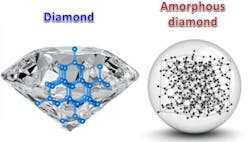Amorphous diamond could be new optical and photonic material
A team of high-pressure physicists at the Carnegie Institution for Science (Washington, DC) has created a form of carbon that is hard as diamond, but amorphous, lacking the large-scale structural repetition of a diamond's crystalline structure.1 The material could have interesting optical, thermal, and mechanical properties.
The differing properties of amorphous forms of carbon, such as coal, and crystalline forms, such as diamond and graphite come, in part, because the carbon atoms that comprise them are bonded in different configurations. Diamonds have an sp3 bonding structure, while the carbon in graphite is held together with sp2 bonds.
Changes to the configuration of the carbon bonds that shape any of these substances can be induced by altering external conditions, such as temperature and pressure.
Other similar elements to carbon—germanium and silicon—have forms that are composed entirely of extremely strong sp3 bonds, and are yet amorphous. But until now, a similar phase of carbon had never been synthesized.
The team was able to create amorphous diamond by bringing a structurally disordered form of carbon called glassy carbon up to nearly 500,000 times normal atmospheric pressure (50 gigapascals) and about 2,780 °C. This is a temperature and pressure range than has not been explored in the efforts to create amorphous diamond.
The sample they created retained its structural change and incompressibility once it was returned to ambient temperature and pressure. In addition, spectroscopy demonstrated that their new material features sp3 carbon bonds, despite being amorphous and lacking the order of a crystal.
"Our amorphous diamond is dense, transparent, super-strong and potentially superhard with more incredible properties yet to be discovered," says Qiaoshi Zeng, one of the researchers.
The next steps for researching this amorphous diamond's properties will be measuring its hardness, strength, optical properties, and thermal stability.
Source: https://carnegiescience.edu/node/2226
REFERENCE:
1. Zhidan Zeng et al., Nature Communications (2017); doi: 10.1038/s41467-017-00395-w

John Wallace | Senior Technical Editor (1998-2022)
John Wallace was with Laser Focus World for nearly 25 years, retiring in late June 2022. He obtained a bachelor's degree in mechanical engineering and physics at Rutgers University and a master's in optical engineering at the University of Rochester. Before becoming an editor, John worked as an engineer at RCA, Exxon, Eastman Kodak, and GCA Corporation.
